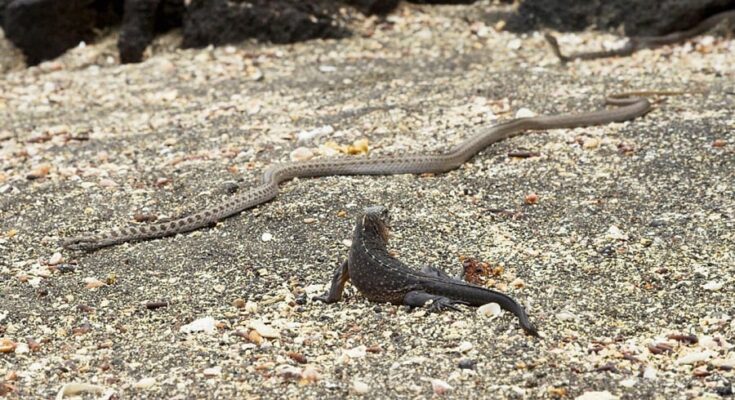
Dubbed as the most dramatic chase in documentary history, the following scene was captured on a beach on Fernandina Island, one of the unspoiled volcanic Galápagos Islands off the coast of Ecuador, by the production team of BBC’s Planet Earth II.
It features an iguana instinctively staying still at first, hoping to elude detection as a racer snake slithers up from behind.
When it becomes clear that the snake is going to strike, the iguana races off, but racer snakes pour out of cracks from the rocks along the beach, joining the chase.
The dramatic footage below, shot in 2016 and narrated by Sir David Attenborough, follows the chase.
“Difficult to watch” chase in documentary
Dr. Elizabeth White, a former research biologist and Planet Earth II producer said that it wasn’t easy for anyone on the crew to watch the scene portrayed in this clip—not to mention the other iguana and snake showdowns—unfold.
“The fact that he made it up the rock safe was absolutely amazing,” Dr. White says of the survivor. “We celebrated. Every time one got away we celebrated.”
“As a filmmaker, half of you wants the snakes to win,” she admits, “and another half of you is like, ‘I want this little one to get away!’ You kind of feel like you get to know an animal even if you are just watching it through binoculars for a few minutes. Those iguanas, they’re so young. They literally may have had just a few minutes experience of life, and they get caught, and that just seems brutal.”
The producer noted that the film crew didn’t expect to find so many snakes hunting a single iguana. It was just one of those times in wildlife filmmaking when a crew stumbles upon an extraordinary situation.
Iguana is a genus of herbivorous lizards that are native to tropical areas of Mexico, Central America, South America, and the Caribbean.
The genus was first described in 1768 by Austrian naturalist Josephus Nicolaus Laurenti in his book Specimen Medicum, Exhibens Synopsin Reptilium Emendatam cum Experimentis circa Venena.
Two species are placed in the genus, the green iguana, which is widespread throughout its range and a popular pet, and the Lesser Antillean iguana, which is native to the Lesser Antilles.
Genetic analysis indicates that the green iguana may comprise a complex of multiple species, some of which have been recently described, but the Reptile Database considers all of these as subspecies of the green iguana.
The species is a popular choice for pets, and non-native animals have been widely introduced beyond its native area, into Ishigaki Island, the Florida Peninsula, Hawaii, Singapore, Thailand, Taiwan, and numerous islands with native Iguana populations in the Lesser Antilles.



